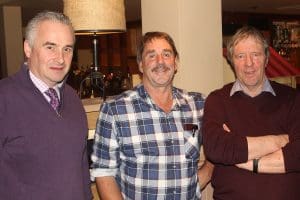VICTORIAN saleyard managers have been advised to avoid double scanning of sheep if possible to minimise equipment, labour costs and scanning rate discrepancies, at a meeting with the United Kingdom’s leading auctioneer association.

UK Livestock Auctioneers’ Association CEO Chris Dodds, left, with ALSA executive officer Mark McDonald and Shearwell Data director Richard Webber.
As the Australian Livestock Saleyards Association tour of English livestock markets continues this week, the Victorian managers are collecting information on scanning rates, equipment efficiency, software and tag reading accuracy.
Some Victorian managers are already adamant they will be scanning sheep twice – possibly on loading and unloading ramps – to meet or exceed the state’s 80 percent scanning compliance rate and PIC transfer rules, and avoid livestock movement mistakes before and sale.
Some tour members also feel that in-pen wand scanning of sheep as seen in the UK saleyards has an unacceptable occupational health and safety risk and will be impractical for scanning large saleyard pen lots, but useful for smaller tail-end lots in small pens.
UK Livestock Auctioneers’ Association chief executive officer Chris Dodds and representatives of Shearwell Data and Newline ASP met with the ALSA tour members at Droitwich in England’s Midlands.
The Livestock Auctioneers’ Association is the UK’s national organisation representing auctioneering firms which run the livestock auction markets of England and Wales.
Most English livestock markets are scanning sheep and lambs pre-sale just once, and Mr Dodds said two scans were not needed in the UK system.
However, one Victorian saleyard manager said two scans would be needed to offer a guarantee to buyers that the sheep they bought will be delivered. The first scan will be on the ramp coming into the saleyard off the truck and the next post-sale as the sheep and lambs are loaded.
“I propose to automate the whole scanning process, so while you are saying it is costing you man-hours I propose to take those man-hours out.
“Two reads, first in, last out (through race readers on the ramps),” the manager said.
“We’ll scan them on the ramps and that guarantees that whatever goes, goes to that destination PIC ultimately, because sheep don’t stay in those delivery pens, they jump and the drovers aren’t real good, they box things up.
“And after the agent has gone home, you will often see the drovers re-drafting with their eyes what they think,” the manager said.
“They (the buyers) want the guarantee that when they stand in front of a pen that they are the sheep that they are going to get and that’s the only way that I can see that we can guarantee that they are going to get those sheep.”
When EID was first introduced in the UK, Mr Dodds said the industry also debated “the big question” as to whether there was a need for one or two reads – into the market and out.
“Our argument always was that we don’t need two reads, because the farmer who has bought his stock in wants to be paid for the stock he has sold, so if he is one sheep short he is banging on the door at the end of the day wanting to be paid for it.
“And we want to make sure we charge the buyer for everything that’s gone out,” he said.
“So if we do one read at the right stage of the process, there is absolutely no need (for a second read).”
Mr Dodds said an Aleis reader then had a purchase cost of about 20,000 pounds and if UK markets had needed to do in-out reads they might have needed five or six of the readers. Market owners refused to entertain the extra cost of reading twice.
He said Victorian saleyard managers might find that their lay-outs allowed them to read sheep twice efficiently.
“My concern would be that you have to be confident that you are going to get that read rate.”
The manager said the saleyard had already done sheep flow and tag trials through race readers.
Mr Dodds said the English system was a good system but it had taken six or seven years to get to its current position.
“The systems, the readers, everyone knows what they are doing now, it is a different world now.”
“We had a situation where it was sprung on us and we had six months to get ready,” Shearwell Data director Richard Webber said.
Mr Webber said the UK system also had the two tag technologies – half duplex HDX and full duplex FDX.
Interference with FDX was a serious problem, he said.

HAVE YOUR SAY